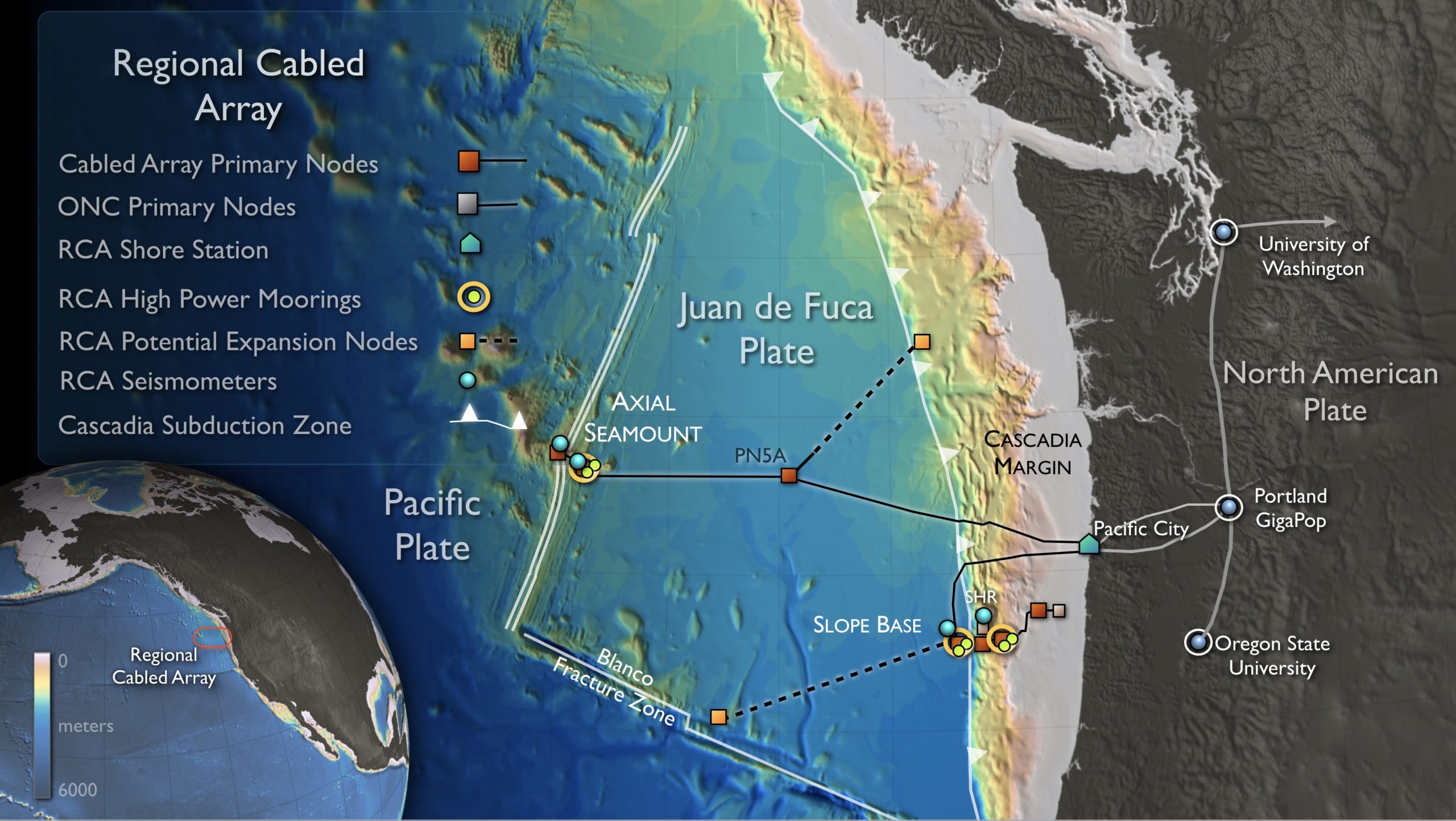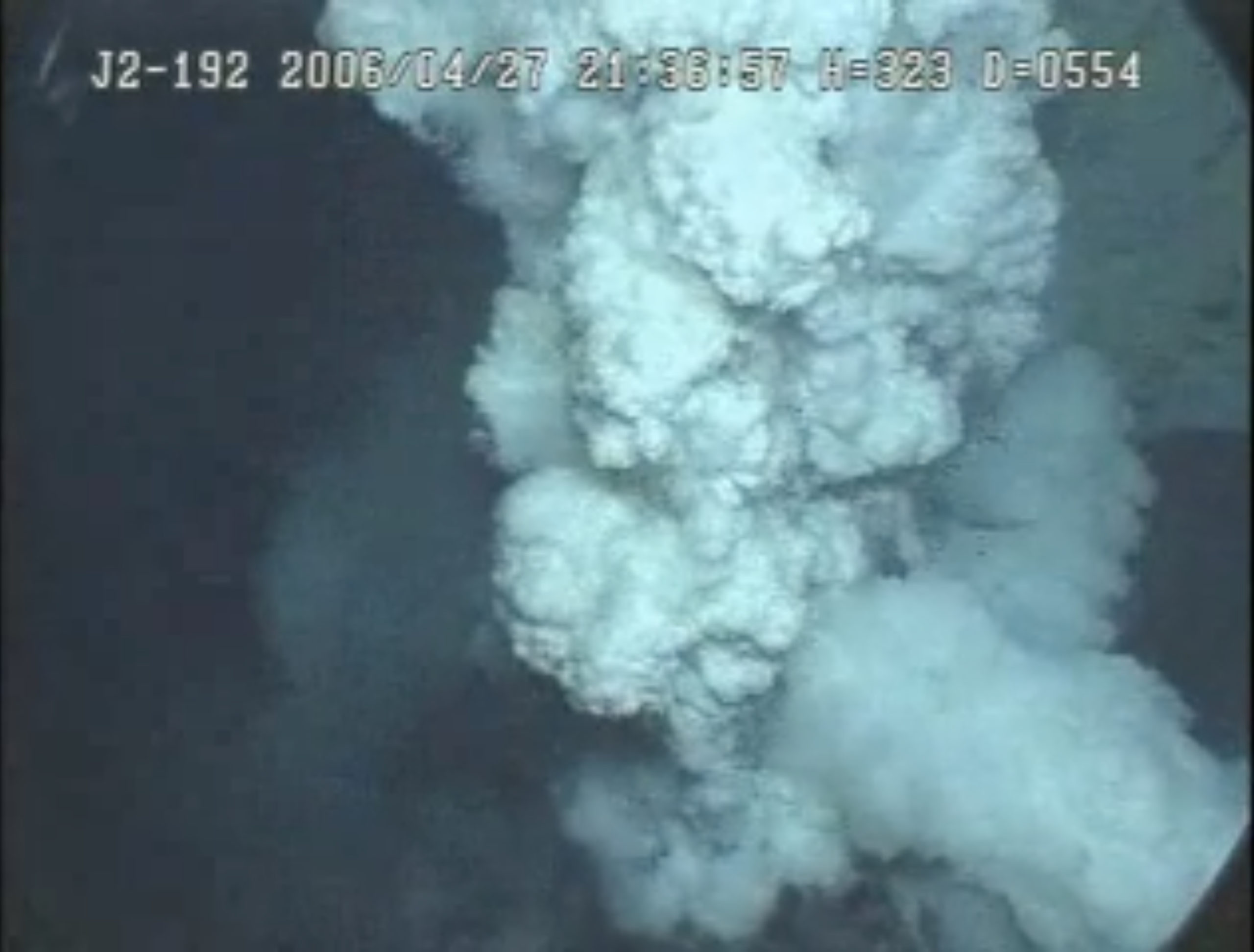Image Archive





























A Beroe ctenophore (comb jelly) seen at Pinnacle, near Southern Hydrate Ridge. Soft corals attached to authigenic carbonate outcrops can be seen in the background. Credit: UW/NSF-OOI/CSSF, Dive R2228, V22.

Pillow basalts, exhibiting classic bread crust texture, are home to brittle stars and star fish at the summit of Axial Seamount, Credit: UW/NSF-OOI/CSSF; V22.

The anhydrite-CO2-rich vent 'Diva" in the International District sprouts numerous fragile chimneys emitting gas-rich fluids with CO2 bubbles in 2022. Credit: UW/NSF-OOI/CSSF; V22.

An IGT sampler for fluids-gases is used by the ROV ROPOS in the large >300°C orifice on the side of Escargot in 2022. The orifice is lined with a copper-rich mineral called chalcopyrite. Credit: UW/NSF-OOI/CSSF; V22.

Hermit crab seen at Pinnacle near SHR during VISIONS'22. Photo credit: NSF-OOI/UW/CSSF, Dive R2228, V22

Hermit crab with an anemone on its shell, seen at Pinnacle near SHR during VISIONS'22. Photo credit: NSF-OOI/UW/CSSF, Dive R2228, V22

Blue ciliates, tube worms, bacteria, limpets and a single squat lobster are supported by diffusely venting fluids near the base of the sulfide edifice called Escargot. Credit: UW/NSF-OOI/CSSF; V22.

The El Gordo vent hosts a colorful array of life, as seen in 2022 with ROPOS. Blue ciliates, sulfide worms, tube worms, and bacteria cover the landscape. Friable chimneys of fine grained sulfide and anydrite are actively venting. Credit: UW/NSF-OOI/CSSF/V22.

Brown anemones, thousands of limpets, scale worms, bacteria and sea spiders cover the diffuse flow site near the OSMO fluid sampler in 2022. Credit: UW/NSF-OOI/CSSF; V22.

A small catshark swims past the ROV ROPOS in 2022 at Southern Hydrate Ridge. Credit: UW/NSF-OOI/CSSF; V22.

Southern Hydrate Ridge is now an 'essential fish habitat". Here, rockfish, hagfish and crabs are commonly seen with the ROV as will as clam chaff away from the seeps. Credit: UW/NSF-OOI/CSSF;V22.

Brown anemones are thriving in a diffuse flow site in teh ASHE hydrothermal field. The site also hosts thick microbial mats, filamentous bacteria, tubeworms and limpets. Credti: UW/NSF-OOI/CSSF; V22.

A beautiful octopus hanging out on a rubbly sheet flow in the ASHES hydrothermal field, spotted by ROPOS adjacent to a diffuse flow site. Credit: UW/NSF-OOI/CSSF/V22/

Elementor-post-screenshot_21963_2023-06-06-19-02-40_25479b5b.png

This bathymetric map shows the location of the 2011 and 2015 lava flows in the caldera of Axial Seamount and along the northern rift and the hydrothermal fields (e.g. International District) and diffuse flow sites and other vents. Credit: M. Elend, University of Washington. The bathymetry is courtesy of D. Caress, Monterey Bay Aquarium Research Institute.

Environments at Axial Seamount

"Bathtub" rings mark the egress of lava in collapsed lava lake from the 2011 eruption in Axial Caldera. Credit: UW/NSF-OOI/WHOI; V17.

A basaltic pillar stands in a collapsed lava lake from the 2011 eruption in Axial Caldera. "Bathtub rings mark the egress of lava. Credit: UW/NSF-OOI/WHOI; V17.

Arches capped by glassy basalts remain in a collapsed lava lake at the summit of Axial seamount. Credit: UW/NSF-OOI/WHOI; V17.

An underwater cave filled with rubble from a collapsed lava lake is capped by glassy flows. Credit: UW/NSF-OOI/WHOI; V17.

An odd basalt formation at the edge of a small, collapsed and frozen lava lake is colonized by tubeworms. Credit: UW/NSF-OOI/WHOI; V17.

Axial Seismometers

The RCA hosts an array of seismometers associated with Axial Seamount and the Cascadia Margin. Credit: University of Washington.

Axial Seamount Earthquakes

Making a Volcano

A rare view of an underwater eruption, this one at the West Mata Volcano located in Lau Basin southwest of Samoa.

This video was captured during the Submarine RIng of Fire 2006 Exploration as part of the NOAA Vents Program.

The 2015 eruption of Axial Seamount along the northern rift culminated in a 127 m thick lava flow. Three months after the eruption, during the Regional Cabled Array VISIONS'15 cruise, the remotely operated vehicle ROPOS captured the first images of the flow, landing 10 m away from its base. The summit was covered in acres of microbial mats. Credit. D. Kelley, University of Washington, UW/NSF-OOI/CSSF
- Anemone
- Animal
- Arthropod
- ASHES
- Axial
- Axial Base
- Axial Biology
- Axial Caldera
- Bacteria
- Basalt Lava
- BEP
- Biofouling
- biolgoy
- Biology
- Camds
- Camera
- Camhd
- Central Caldera
- Ciliates
- Cnidaria
- Coastal Biology
- Crab
- Deep Profiler Mooring
- Dive Highlights
- Eastern Caldera
- Echinoderms
- Endurance Array
- Engineering Team
- ENLIGHTEN 10
- Exploratorium
- Fish
- Geology
- HD Camera
- HPIES
- Hydrate Ridge
- Hydrates
- Hydrophone
- Hydrothermal Vents
- Illustration
- Inshore 80 Meters
- Instrument
- International District
- J-BOX
- Jason
- Jellyfish
- Junction Box
- K12
- Lava
- Mollusk
- Moorings
- Nodes
- Nudibranch
- Octopus
- OOI
- Oregon Offshore
- Oregon Offshore 600 m
- Oregon Shelf
- Oregon Slope Base
- People
- PN1B
- PN1D
- Polychaetes
- PPSDN
- Primary Node
- RASFL
- ROCLS
- ROPOS
- ROPOS Dives
- ROV Team
- RV Revelle
- RV Sikuliaq
- RV Thompson
- Salp
- Sample
- SC13
- Science Team
- Sea Cucumber
- Sea Star
- Sea Urchin
- Seafloor
- Seismometer
- Sensors
- Shallow Profiler Mooring
- Shark
- Shipboard
- Shore Station
- Slope Base
- Smoker
- Soft Coral
- Southern Hydrate Ridge
- Sponge
- Squid
- Students
- Students & Guest Participants
- Tmpsf
- Tubeworms
- VISIONS 11 Leg 1
- VISIONS 11 Leg 2
- VISIONS 11 Viewers
- VISIONS 13
- VISIONS 14
- VISIONS 15
- VISIONS 16
- VISIONS 17
- VISIONS 18
- VISIONS 20
- VISIONS 22
- VISIONS 23
- Visualization
